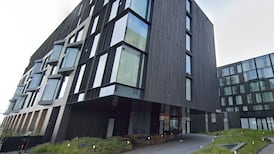Kip Carroll's background is in fashion photography. But in his new exhibition, scenes of life from Vietnam, Nepal and India offer observations of a tranquil life that is all at risk, he tells Gemma Tipton
The best photography tells us how to see particular things, describes what we should be looking for in the picture. In fashion photography, we are pointed to glamour, drama, beauty; to find desire for this jacket, that lipstick, those tights. In fine art photography, we are directed toward something different, invited to find a feeling, a mood, an echo of the sense the photographer felt when they chose to make this image, at this moment, and cropped out everything else that might detract and distract.
In Kip Carroll's new exhibition at Dublin's Bridge Gallery, what we are directed to are scenes of life from Vietnam, Nepal and India. Incredibly beautiful landscapes are exotic yet oddly familiar; there are half-ruined temples, with soft stone crumbling back into nature; and there are also people - people working, meditating, or caught in moment of daily life.
"They are," says Carroll, "snapshots, trying to capture something, to hold onto something I felt I might want to see again later."
Best known up until now as a fashion photographer, Carroll has been taking these pictures for a decade. He has always had a fascination with India, but his first trip to Vietnam was as a groom with his wife, Nguyen. Nguyen had come to Ireland as a seven-year-old with her parents in the late 1970s, one of the first Boat People to arrive in this country, fleeing the Vietnam War. The family settled in Drogheda, the children going to local schools. "Nguyen is the only one of the kids not to have a Drogheda accent," says Carroll.
The couple met on a photoshoot for hats - she was the model, and he was the photographer. Was it love at first sight? "It was for me," he says.
About 200 Vietnamese people came to Ireland at that time. Some have since returned to their home country, others have made a life here, while still others, like Nguyen's parents, divide their time between the two countries. The Vietnam of Carroll's photographs is a timeless one, showing ancient buildings and a landscape almost unaltered by the passing of the years. And yet it is changing.
"The countryside is staggeringly beautiful," says Carroll. "I grew up in Lanesborough in Longford, so I'm a country boy, and it can be quite hard for country people to see beauty in cities. When I first started going to Vietnam, the lack of money there meant that the cities were quite run down. You could see wobbly extensions hanging off beautiful old buildings. But that's all changing now. Everyone used to have bicycles, now they have motorbikes and cars."
Carroll describes a poverty that could be in danger of being aestheticised; made picturesque for the purposes of art. "But they are a happy people," he observes. "Whether they were working in the paddy fields, or in the cities, they are happy, and lucky to live in such a beautiful place."
He describes his photographs as snaps - "they are observations of their life, which is peaceful and tranquil." Carroll's images also show a place that still lacks plastic and concrete. "I love the way they use materials over there, the wood, a banana-leaf raft, dug-out boats. But it's all at risk. Just as we changed in Ireland, Vietnam too is changing. The plastic chairs are coming."
In fact, Nguyen's parents can't understand why their son-in-law chooses the subjects he does. Why doesn't he want to photograph the new housing estates, the modern buildings? Nguyen herself, he says, "is a little more like me. She understands how Vietnam is changing, but she also likes her comforts."
And that is the conundrum we all have to face up to. Development destroys beauty, and yet brings its own rewards, the balance to be found lies between unchecked "progress", and poverty-stricken stagnation, however picturesque.
Looking at it like that, Carroll's images are focusing our attention on what is special to Vietnam, what makes it such a unique and magical place, holding a moment in the country's history, rather than simply romanticising it for an outsider's gaze.
"I hope to continue with this sort of work," he says. "To have more time to put into it, to work with different kinds of light, to get better at it. I'd like to take photographs here as well, to try to get the same sort of feel in images of Ireland. It's all about finding and capturing beauty."
The Vietnam, India and Nepal that he has found and captured is beautiful. A city scene that could appear from another perspective as chaotic and impoverished comes across instead as full of life and movement. Some images, nonetheless, still bring you up short. A small girl with a large basket on her back does feel "wrong". It remains to be seen, however, whether the kind of progress that heralds plastic chairs and Barbie dolls will make life in her country a better one.
Time and Place by Kip Carroll is on at the Bridge Gallery, Dublin from November 23 to December 3. www.thebridgegallery.com









